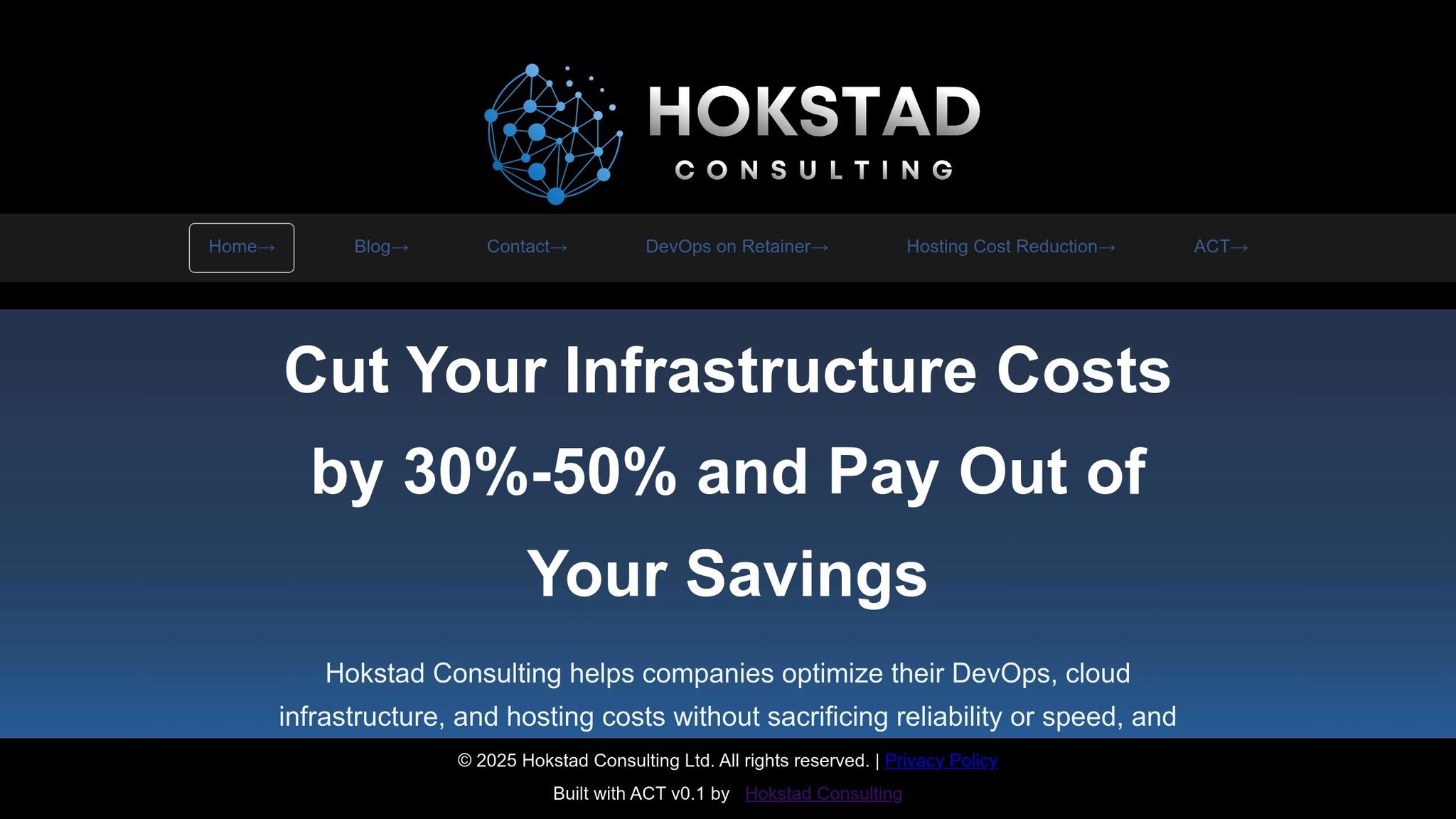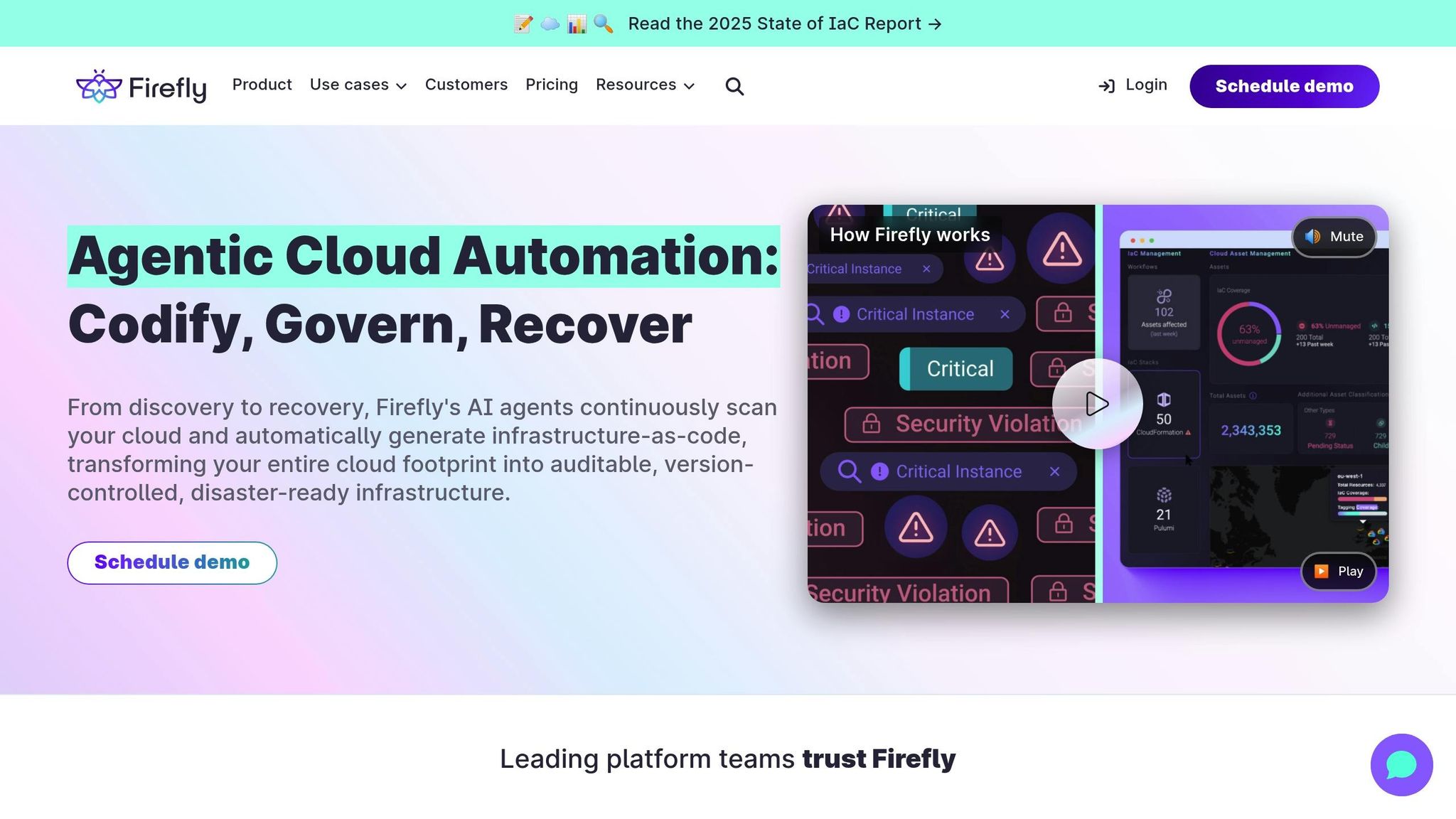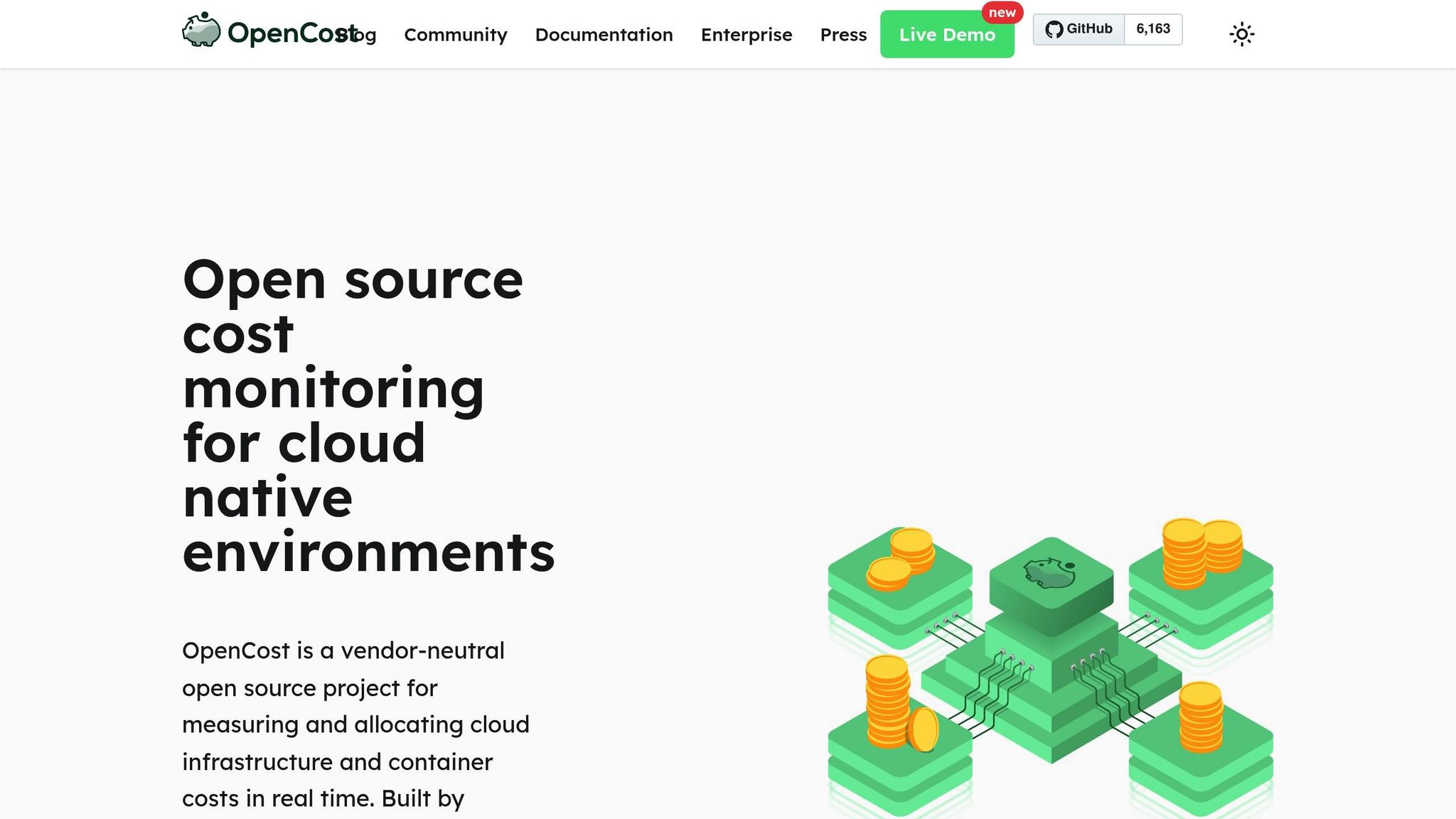Cost-aware CI/CD integrates cost management into every stage of your software development pipeline, helping teams reduce cloud expenses while maintaining deployment speed. By embedding cost monitoring, resource optimisation, and policy enforcement into workflows, businesses can save 10–50% on cloud costs and eliminate inefficiencies like over-provisioned resources or idle environments. Here's what you need to know:
- Why it matters: UK businesses spend up to 30% of their cloud budgets on unused resources. Real-time cost visibility and automation can prevent this waste.
- Key features: Tools offer dashboards for tracking costs, automated scaling to match resource use, and policy-as-code frameworks to enforce budgets and compliance.
- Top tools: Options include Hokstad Consulting (tailored solutions for UK needs), Firefly AI (multi-cloud management), nOps (AWS-focused), Cloud Custodian (open-source policy enforcement), and OpenCost (Kubernetes cost tracking).
Quick Wins: Start by integrating cost monitoring into your CI/CD pipelines, automate resource scaling, and enforce budget policies. For complex setups, expert consulting can deliver faster results and higher savings.
CI/CD Cost Optimisation for Dev Environment | FinOps
Key Features of Cost-Aware Workflow Automation Tools
Choosing the right cost-aware CI/CD tools means identifying features that genuinely enhance your organisation's ability to manage cloud expenses and resource usage. The best platforms share several capabilities that reshape how teams handle these challenges.
Real-Time Cost Visibility and Reporting
Accurate, up-to-the-minute cost tracking is crucial for managing expenses effectively. Leading tools offer detailed dashboards that break down cloud spending by team, environment, or product line, giving teams clear insights into where their budget is going. For instance, CloudZero's dashboards align cloud spend with specific business areas, allowing teams to set spending limits that match their budgets.
For UK organisations, these dashboards are especially helpful in managing VAT and departmental budgets. Teams can monitor expenses in real time and rely on automated systems to flag unusual spending patterns before they disrupt budgets. Many tools integrate seamlessly with existing financial processes, displaying costs in pounds sterling and adhering to UK date formats (DD/MM/YYYY) [2][6].
Let’s explore how automated resource scaling builds on this functionality to enhance cost efficiency.
Automated Resource Scaling and Lifecycle Management
Dynamic resource scaling has become one of the most effective ways to cut costs. Tools like CAST AI use machine learning to analyse workloads continually, automatically adjusting node sizes, scaling clusters, and redistributing workloads across cloud providers [6]. This is particularly valuable during seasonal peaks or periods of high demand.
These tools monitor resource usage in real time, adjusting provisioning as needed. For example, when testing environments are no longer active, automated lifecycle management shuts down idle resources, avoiding unnecessary overnight charges. Right-sizing ensures production environments have the resources they need without over-provisioning, while development and testing environments scale down during downtime.
Organisations using these strategies have reported savings of 30–50%, with some cutting annual infrastructure costs by more than £40,000 through optimised cloud management [1].
Policy Enforcement for Cost and Compliance
Policy-as-code frameworks bring budget controls and compliance rules directly into CI/CD workflows. A great example is Cloud Custodian, which uses event-driven, YAML-defined policies to enforce cost and compliance measures in real time. It integrates with services like AWS Lambda, as well as similar tools on Azure and Google Cloud [3].
These automated policies help prevent budget overspending and unauthorised resource usage, ensuring compliance with GDPR and other UK regulations. Teams can also enforce tagging, lifecycle, and access policies, creating a system where cost management and compliance are seamlessly aligned.
Integration with Developer Workflows
For cost-aware features to be effective, they must integrate smoothly into existing development workflows. Tools like Harness do just that by embedding cost visibility into CI/CD pipelines. This allows developers to see the cost impact of their changes before deployment [6][4]. This shift-left
approach promotes cost-conscious development and encourages widespread adoption among engineering teams.
With successful implementations, developers can access cost insights directly within pull requests, build logs, and deployment dashboards. This makes it easy to review the financial impact of changes alongside performance and security metrics. Integration with popular tools like version control systems and ticketing platforms ensures that cost data is available where developers already work [2][7]. These systems also provide actionable recommendations for optimising resource usage [2][5].
This level of integration lays the groundwork for managing more complex cloud environments.
Support for Multi-Cloud and Hybrid Environments
As organisations increasingly adopt diverse cloud strategies, unified multi-cloud management has become indispensable. The best tools provide compatibility across public clouds (like AWS, Azure, and Google Cloud), private clouds, and on-premises systems. Unified dashboards and cross-cloud cost allocation make it easier to maintain a clear view of expenses [6][3].
Choosing between public, private, and hybrid solutions feels overwhelming. You need expert guidance to make the right decisions.
– Hokstad Consulting [1]
Platforms like CAST AI and Firefly AI allow teams to manage resources and enforce policies across multiple providers, reducing reliance on any single vendor and improving operational flexibility. For UK businesses, this adaptability supports tailored cloud strategies that optimise spending in pounds sterling while meeting data residency requirements.
By enabling teams to shift workloads between providers based on pricing, availability, or compliance needs, these tools ensure that resources are always deployed in the most cost-effective way. This approach balances cost efficiency with performance and security, no matter how complex the infrastructure.
We analyse your specific needs to design the perfect hybrid, private, or public cloud solution that balances cost, performance, and security.
– Hokstad Consulting [1]
With these capabilities, organisations can create cloud strategies that are both efficient and adaptable, meeting the demands of diverse environments without overspending.
Top Cost-Aware CI/CD and Workflow Automation Tools
When it comes to managing cloud expenses while maintaining efficient deployment workflows, several tools stand out for their ability to integrate cost-awareness into CI/CD processes. These platforms offer a variety of solutions, from AI-powered optimisation to open-source transparency, catering to organisations with diverse needs and technical capabilities.
Hokstad Consulting

Hokstad Consulting is a UK-based consultancy that specialises in DevOps transformation and cloud cost engineering. They focus on delivering tailored solutions that combine automation with strategic guidance to achieve measurable results.
Their services include implementing automated CI/CD pipelines, Infrastructure as Code, and monitoring systems, which have been shown to reduce deployment times by 75% and cut errors by 90%. On the cost management front, their cloud cost engineering strategies aim to slash infrastructure spending by 30–50% through techniques like right-sizing, automation, and efficient resource allocation.
Hokstad Consulting’s performance-based pricing model resonates with UK businesses, as fees are often tied to the savings they help achieve. For example, a SaaS company reduced costs by £96,000 annually, an e-commerce platform improved performance by 50% while cutting expenses by 30%, and a tech startup brought deployment times down from six hours to just 20 minutes.
Their expertise extends beyond traditional DevOps, offering support for AI strategies and automation to drive cost savings across other business areas. Tools like Firefly AI build on this approach, offering advanced automation features.
Firefly AI

Firefly AI takes cost optimisation a step further by integrating asset management, compliance enforcement, and cost controls into a single platform. This all-in-one design simplifies cloud management, offering a clear view of resources and expenses across environments.
Key features include automated scaling and real-time anomaly detection, which adjust resources dynamically during CI/CD processes without manual adjustments. The platform’s asset management tools track cloud usage, while its AI capabilities analyse patterns to provide actionable recommendations for cost efficiency.
Firefly AI is particularly suited to mid-to-large teams managing complex cloud setups, thanks to its custom enterprise pricing model that reduces operational overhead.
nOps

nOps focuses on providing cost intelligence and enforcing budget policies within CI/CD pipelines. The platform’s dashboards and spending alerts offer granular visibility into cloud expenses, helping teams identify and address cost drivers early.
With automated policy enforcement, teams can set spending thresholds and receive real-time notifications when costs exceed limits. nOps can also take immediate action, such as scaling down non-essential resources or pausing costly operations until reviewed. For smaller teams, nOps offers free tiers with basic cost tracking capabilities.
Cloud Custodian

Cloud Custodian uses a policy-as-code approach, allowing organisations to define rules in YAML for managing cloud resources. Its event-driven architecture ensures that policies are enforced in real time, whether triggered by resource creation, modifications, or breaches of metric thresholds.
The tool offers flexibility with its audit-only mode for monitoring or full remediation mode for automated enforcement. As an open-source solution, it provides transparency and avoids licensing fees, though it may require more technical expertise to implement effectively.
OpenCost

OpenCost is tailored for Kubernetes-based CI/CD pipelines, offering detailed insights into resource usage and costs at the container level. It enables organisations to attribute expenses to specific namespaces, deployments, or teams, making it easier to identify cost-driving applications.
The platform integrates seamlessly with existing Kubernetes tools, allowing teams to access cost data through familiar interfaces. This makes it simple to incorporate financial metrics alongside operational ones in monitoring dashboards.
As an open-source tool, OpenCost is free to use and benefits from community-driven development, ensuring it evolves alongside Kubernetes best practices. Its transparency and flexibility appeal to organisations seeking vendor independence.
These tools showcase a range of approaches to embedding cost-awareness into CI/CD workflows. Whether working with a consultancy like Hokstad Consulting or leveraging open-source solutions like OpenCost, organisations can find tools that align with their technical capabilities and financial goals. By integrating cost insights into deployment decisions, businesses can achieve more efficient resource management and long-term savings.
Need help optimizing your cloud costs?
Get expert advice on how to reduce your cloud expenses without sacrificing performance.
Comparison: Cost-Aware CI/CD Tools
Choosing the right CI/CD tool depends on your organisation's specific needs, technical expertise, and budget. Each platform brings distinct strengths to the table. The comparison below offers a quick snapshot of their features, pricing, and suitability.
Feature and Pricing Comparison Table
| Tool | Target Use Case | Key Features | Pricing (GBP) | Strengths | Limitations |
|---|---|---|---|---|---|
| Hokstad Consulting | Custom cost optimisation & DevOps transformation | Bespoke automation, expert guidance, performance-based pricing | Custom fees (often capped at savings percentage) | Tailored solutions, UK expertise, risk-free savings model | Requires consulting engagement, not a plug-and-play product |
| Firefly AI | Multi-cloud policy enforcement & CI/CD integration | Real-time drift detection, policy-as-code with OPA, pre-deployment checks | Subscription-based (custom enterprise pricing) | Deep CI/CD integration, strong policy enforcement | Complex setup, requires technical expertise |
| nOps | AWS-focused cost management & automation | Automated monitoring, anomaly detection, real-time alerts | Subscription-based, with a free tier available | Strong AWS integration, automated insights | AWS-centric, costs can rise at enterprise scale |
| Cloud Custodian | Event-driven policy enforcement | YAML-based policies, multi-cloud support, real-time enforcement | Open-source (free) | Highly customisable, no licensing fees | Demands advanced technical expertise |
| OpenCost | Kubernetes cost monitoring | Container-level cost allocation, real-time insights, community-driven | Open-source (free) | Kubernetes-native, transparent, extensible | Limited to containerised environments |
Key Insights for Decision-Making
Hokstad Consulting offers a standout performance-based pricing model, appealing to UK businesses aiming to slash infrastructure costs. Their fees are often tied to the savings achieved, which can range from 30% to 50%. Clients typically save over £50,000 annually, making it a compelling option for organisations looking for expert-driven, risk-free cost reduction.
For those considering subscription-based tools like Firefly AI and nOps, it's important to evaluate the total cost of ownership. This includes not just subscription fees but also VAT and potential scaling expenses as cloud usage grows. Both tools offer robust features but require careful budgeting to avoid unexpected costs.
Open-source platforms like Cloud Custodian and OpenCost eliminate licensing fees, but they come with their own challenges. Organisations must account for the need for skilled personnel or external support to handle the technical complexity of setup and maintenance.
Multi-Cloud and Integration Considerations
Hokstad Consulting's expertise spans AWS, Azure, Google Cloud, and private clouds, making it versatile for multi-cloud and hybrid strategies. Similarly, Cloud Custodian supports AWS, Azure, and GCP with a unified policy management system. In contrast, nOps is primarily focused on AWS, while OpenCost is limited to Kubernetes workloads.
When it comes to integration, Firefly AI excels with native CI/CD compatibility, offering pre-deployment cost and compliance checks. Cloud Custodian provides flexible policy frameworks adaptable to various deployment scenarios, while OpenCost is designed to integrate seamlessly with Kubernetes tools but lacks support for non-containerised environments.
Compliance and Local Needs for UK Organisations
For UK enterprises, compliance with GDPR, audit logging, and local data residency regulations is often a critical factor. Hokstad Consulting incorporates these standards directly into their automation strategies, while Firefly AI and Cloud Custodian offer policy-as-code frameworks to address compliance needs.
Ultimately, the choice comes down to your organisation's maturity, cloud goals, and available resources. If immediate cost reductions and expert guidance are priorities, Hokstad Consulting's model is hard to beat. On the other hand, technically adept teams may prefer the flexibility and control offered by open-source tools like Cloud Custodian and OpenCost.
Implementation Methods and Best Practices
Incorporating cost-awareness into automation doesn’t mean sacrificing speed. By embedding financial metrics directly into the CI/CD lifecycle, you can keep processes efficient while maintaining budget control.
Adding Cost Insights to Pipelines
Cost monitoring shouldn’t be an afterthought. Instead, integrate it at critical stages of your CI/CD pipelines, ensuring developers have real-time visibility into spending. Successful teams weave cost metrics into their workflows from the start, making spend data a natural part of the development process[6][5].
Key Integration Points focus on stages where cost impact is most pronounced. For example, after build stages, display resource usage metrics, and during pre-deployment checks, flag potential budget overruns. Tools like Harness CCM are particularly effective, offering Kubernetes and multi-cloud spend data directly within developer interfaces[5][2]. This seamless integration ensures that cost considerations don’t disrupt workflows but instead enhance decision-making.
Automated Reporting and Alerts play a crucial role in maintaining cost visibility. Set up pipelines to generate automatic cost reports after each deployment. These reports can show not only the amount spent but also how it compares to previous builds and budget targets. According to industry surveys, organisations using automated cost management tools report up to 30% reductions in cloud waste and 20–40% improvements in budget forecasting accuracy[2][6].
To ease adoption, start with audit-only modes to build confidence. Gradually introduce cost gates to enforce budget limits. These practices lay the groundwork for automated resource management, which is the next step.
Automating Resource Management
Lifecycle Automation is one of the most effective ways to cut costs in CI/CD environments. By automating resource management through lifecycle policies and AI-driven tools, you can eliminate waste and optimise usage. For instance, automation can terminate unused resources, schedule scaling, or enforce tagging standards[3].
AI-Powered Optimisation is becoming increasingly common for managing resources. Tools like Densify and Firefly AI use machine learning to analyse usage patterns and recommend rightsizing during deployments[2][3]. This eliminates guesswork in capacity planning, ensuring resources are aligned with actual demand instead of peak estimates.
Policy-as-Code Implementation allows teams to define and automate resource management rules. For example, development environments can be programmed to shut down after business hours, while production systems scale dynamically based on load. These policies, embedded in infrastructure code, ensure consistency across teams and environments.
The most effective strategy combines multiple automation layers. For example, implement automated rightsizing for long-running resources, scheduled shutdowns for development environments, and real-time scaling based on demand. Organisations using such strategies often achieve 30–50% cost reductions through proven optimisation techniques[1]. For more complex setups, expert guidance can help maximise these savings.
Working with Consulting Experts
Collaborating with experts can help you unlock the full potential of cost-aware automation, especially in complex or regulated environments.
Tailored Strategies are essential for multi-cloud or compliance-heavy setups. Hokstad Consulting, for instance, offers bespoke automation strategies tailored to UK-specific requirements, such as GDPR compliance and data residency rules. Their performance-based pricing model, often tied to the savings achieved, ensures a risk-free approach to implementation.
Faster Implementation is another benefit of expert guidance. By leveraging their knowledge, you can reduce deployment times and improve system performance. This not only accelerates the adoption of automation but also ensures immediate results.
Since cloud environments and business needs are constantly evolving, ongoing optimisation is critical. Regular reviews and policy updates help maintain efficiency. Consulting partners can assist with periodic audits, adjusting automation rules, and integrating new tools as they emerge.
For the best results, combine initial strategy development with ongoing support. This might include quarterly reviews of cost policies, regular resource utilisation audits, and guidance on new techniques. For UK organisations, local expertise is particularly valuable for navigating compliance requirements and adapting cost reporting to reflect currency considerations.
When standard tools fall short, custom development and integration can address unique needs. Consultants can create tailored automation solutions that align with your workflows, eliminating manual overhead and enabling faster deployment cycles - sometimes up to 10x faster[1]. This bespoke approach ensures that your automation strategy is as effective as possible.
Conclusion
Cost-aware CI/CD tools have become a game-changer for UK businesses, offering the dual advantage of cutting cloud expenses and enabling faster, error-free deployments - all while keeping delivery efficient and streamlined [1].
The tools we've explored - like Firefly AI for unified asset management, Cloud Custodian for enforcing policies, and OpenCost for monitoring Kubernetes - highlight how cost visibility and automation can complement development speed. Features such as real-time cost dashboards, automated resource scaling, and policy-driven controls help prevent up to 30% of cloud budgets from going to waste [2]. These capabilities don’t just boost operational efficiency - they also deliver substantial financial gains for organisations across the UK.
The financial benefits go beyond mere cost-cutting. Case studies have shown that adopting these tools can lead to significant annual savings on infrastructure [1].
To make the most of these insights, start by incorporating a few key automation strategies into your workflows. Begin with real-time cost monitoring integrated into your pipelines, automate resource lifecycle management, and establish governance through policy-driven controls. This approach ensures you minimise waste while maintaining deployment speed, embodying the principles of cost-aware CI/CD. For businesses navigating complex multi-cloud setups or operating in compliance-heavy industries, seeking advice from specialists like Hokstad Consulting can help tailor strategies to meet UK-specific needs.
Cost-aware CI/CD isn’t just about saving money - it’s about empowering developers to focus on innovation instead of infrastructure headaches. With deployment cycles up to 10 times faster and practices that scale with your business, you’ll be setting the stage for sustainable growth. Pricing for these tools ranges from free tiers to plans starting at around £24 per user per month. The sooner you implement cost-aware CI/CD practices, the sooner you’ll reap the rewards.
FAQs
How can cost-aware CI/CD tools help UK businesses reduce cloud expenses?
Cost-conscious CI/CD tools offer UK businesses a smart way to reduce cloud expenses. They work by optimising resource usage, automating routine tasks, and ensuring infrastructure is allocated efficiently. With these tools, companies can potentially save between 30% and 50%, all while keeping deployment cycles running smoothly.
Beyond just cutting costs, these tools help pinpoint unnecessary spending, simplify workflows, and improve overall efficiency. For businesses aiming to lower operational costs in cloud environments, they’re an essential part of the toolkit.
What are the advantages of adding real-time cost tracking to CI/CD pipelines?
Integrating real-time cost visibility into CI/CD pipelines allows teams to fine-tune their workflows while keeping a close eye on expenses. By tracking costs as they happen, businesses can pinpoint inefficiencies, cut down on avoidable spending, and make smarter choices about resource allocation.
It also enhances decision-making by offering clear insights into how deployment processes impact the budget. This helps teams strike a balance between performance and cost considerations, encouraging more efficient and sustainable development practices.
How do policy-as-code frameworks help improve compliance and manage costs in CI/CD workflows?
Policy-as-code frameworks bring compliance and cost management straight into your CI/CD workflows by automating the enforcement of rules and policies. With these frameworks, teams can define policies in code, ensuring processes remain consistent and less prone to human mistakes.
By incorporating cost-conscious policies - like setting limits on resource usage or establishing budget thresholds - organisations can avoid overspending while staying aligned with both internal and external standards. This approach not only simplifies workflows but also strengthens governance and keeps budgets under control throughout development pipelines.
